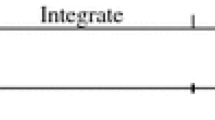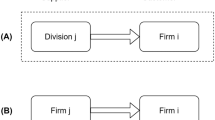Abstract
This paper is aimed at analyzing the relationship between outsourcing and productivity. Specifically, this paper deals with outsourcing at the firm level and focuses on the role of contracting out of manufacturing activities. I obtain new insights on this topic, mainly using a precise measure for outsourcing and analyzing differences across industries. Using an unbalanced panel of Spanish manufacturing firms, I estimate a production function depending on traditional inputs (labor, capital, and materials) and an index of production subcontracting. I find that for manufacturing as a whole, outsourcing intensity has a positive effect on productivity, showing an elasticity of output with respect to outsourcing around 0.15. When analyzing industry level results, I find that outsourcing intensity has a positive effect on productivity, mainly for firms belonging to light industries.


Similar content being viewed by others
Notes
For example, the Oslo Manual (OECD 2005) considers the implementation of new ways of organizing relations with other firms such as the outsourcing or subcontracting to be an organizational innovation.
These industrial services includes activities such as processing of inputs which are then sent back to the establishment for final assembly or sales, maintenance of production machinery, and engineering or drafting services.
I adopt a production function approach because this paper focuses on the relationship between outsourcing and productivity. The estimation of the production function is commonly used in the analysis of productivity (see Ackerberg et al. 2007).
This substitution is commonly used in the context of the logit transform \( {\text {log}}(\frac{z}{1-z}) \), where z is a share ranging from 0 to 1 (see Hall 2011). This issue is related to the estimation of a Cobb–Douglas production function with zero input levels. Empirical literature proposes three main solutions to this problem (see Moss 2000): (i) substituting a small nonzero value for the zero observations; (ii) using a functional form that allows for zero inputs (such as a quadratic production function); and (iii) bootstrapping.
I consider 11 industries. Industry breakdown is defined in Appendix 2.
As I said in Sect. 3, ratio \(\frac{\text {sr}}{1-\text {sr}}\) is an index of production subcontracting. It is not a direct measure of subcontracted purchases, and therefore, measuring the quantitative contribution of outsourcing is not straightforward.
References
Abraham KG, Taylor S (1996) Firms’ use of outside contractors: theory and evidence. J Labor Econ 14:394–424
Abramovsky L, Griffith R, Mari S (2004) Offshoring of business services and its impact on the UK economy. IFS Briefing Note. doi:10.1920/bn.ifs.2004.0051
Ackerberg D, Benkard L, Berry S, Pakes A (2007) Econometric tools for analyzing market outcomes. In: Heckman J (ed) Handbook of econometrics, vol 6. North-Holland, Amsterdam, pp 4171–4276
Amiti M, Wei SJ (2005) Fear of outsourcing: is it justified? Econ Policy 20(42):308–348
Amiti M, Wei SJ (2006) Service offshoring, productivity and employment: evidence from the US. CEPR Discussion Paper No 5475
Anderton B, Brenton P (1999) Outsourcing and low-skilled workers in the UK. B Econ Res 51(4):267–286
Arellano M, Bond S (1991) Some tests of specification for panel data: monte carlo evidence and an application to employment equations. Rev Econ Stud 58:277–297
Bartel A, Lach S, Sicherman N (2012) Technological change and the make-or-buy decision. J Law Econ Organ. doi:10.1093/jleo/ews035
Blundell R, Bond S (2000) GMM estimation with persistent panel data: an application to production functions. Econom Rev 19(3):321–340
Borga M, Zeile WJ (2004) International fragmentation of production and the intrafirm trade of United States multinational companies. Bureau of Economic Analysis WP 2004–2002
Campa J, Goldberg LS (1997) The evolving external orientation of manufacturing industries: evidence from four countries. NBER Working Paper No 5919
Díaz-Mora C (2008) What factors determine the outsourcing intensity? a dynamic panel data approach for manufacturing industries. Appl Econ 40(19):2509–2521
Estevao M, Lach S (1999) Measuring temporary labor outsourcing in US manufacturing. NBER Working Paper No 7421
Falk M, Koebel B (2000) Outsourcing of services, imported materials, and the demand for heterogeneous labour: an application of a generalized Box-Cox function. Centre for European Economic Research (ZEW) Discussion Paper No 2000:51
Feenstra RC, Hanson GH (1995) Foreign investment, outsourcing and relative wages. NBER Working Paper No 5121
Feenstra RC, Hanson GH (1996) Globalization, outsourcing, and wage inequality. Am Econ Rev 41(1–2):240–245
Feenstra RC, Hanson GH (1999) The impact of outsourcing and high-technology capital on wages: estimates for the United States, 1979–1990. Q J Econ 114(3):907–940
Fixler DJ, Siegel D (1999) Outsourcing and productivity growth in services. Struct Chang Econ Dyn 10:177–194
Girma S, Görg H (2004) Outsourcing, foreign ownership, and productivity: evidence from UK establishment-level data. Rev Int Econ 12(15):817–832
Goodman B, Steadman R (2002) Services: business demand rivals consumer demand in driving job growth. Mon Labor Rev 125(4):3–16
Görg H, Hanley A, Strobl E (2008) Productivity effects of international outsourcing: evidence from plant level data. Can J Econ 41(2):670–688
Görzig B, Stephan A (2002) Outsourcing and firm-level performance. German Institute for Economic Research Discussion Paper No 309
Griliches Z, Mairesse J (1998) Production functions: the search for identification. In: Strøm S (ed) Econometrics and economic theory in the 20th century: the Ragnar Frisch centennial symposium. Cambridge University Press, Cambridge, pp 169–203
Hall BH (2011) Innovation and productivity. NBER Working Paper No 17178
Hanson GH, Mataloni RJ, Slaughter MJ (2004) Vertical production networks in multinational firms. NBER Working Paper No 9723
Heshmati A (2003) Productivity growth, efficiency and outsourcing in manufacturing and service industries. J Econ Surv 17(1):79–112
Hummels D, Jun I, Yi KM (2001) The nature and growth of vertical specialization in world trade. J Int Econ 54(1):75–96
McMillan J (1995) Reorganizing vertical supply relationships. In: Siebert H (ed) Trends in business organization: do participation and cooperation increase competitiveness?. JCB Mohr, Tübingen, pp 203–222
Moss CB (2000) Estimation of the Cobb-Douglas with zero input levels: bootstrapping and substitution. Appl Econ Lett 7:677–679
OECD (2005) Oslo manual (3rd edn): proposed guidelines for collecting and interpreting innovation data. Paris
Olsen KB (2006) Productivity impacts of offshoring and outsourcing: a review. STI Working Paper 2006/1
Paul CJM, Yasar M (2009) Outsourcing, productivity and input composition at the plant level. Can J Econ 42(2):422–39
Siegel D, Griliches Z (1992) Purchased services, outsourcing, computers, and productivity in manufacturing. In: Griliches Z (ed) Output measurement in the service sector. University of Chicago Press, Chicago, pp 429–460
Ten Raa T, Wolff EN (2001) Outsourcing of services and the productivity recovery in US manufacturing in the 1980 and 1990s. J Prod Anal 16:149–165
Yeats AJ (2001) Just how big is global production sharing? In: Arndt SW, Kierzkowski H (eds) Fragmentation: new production patterns in the world economy. Oxford University Press, Oxford, pp 108–143
Acknowledgments
I would like to thank José Carlos Fariñas and Jordi Jaumandreu for their valuable suggestions and discussion. I also wish to acknowledge useful comments by Saul Lach and Frank Verboven, and by the audiences at the 32nd EARIE meeting and at the 23rd Annual Congress of the European Economic Association. I thank the editor, Subal C. Kumbhakar, and two anonymous referees for useful comments. I acknowledge financial support from the Ministerio de Ciencia e Innovación (Spain) project ECO2010-18947, and from Fundación Banco Herrero. Errors are mine.
Author information
Authors and Affiliations
Corresponding author
Appendices
Appendix 1: definitions of variables
- Capital stock :
-
Capital at current replacement values is computed recursively from an initial estimate and the data on firms’ investments in equipment goods (but not buildings or financial assets), actualized by means of a price index of capital goods, and using sectorial estimates of the rates of depreciation. Real capital is then obtained by deflating the current replacement values.
- Entrant firm :
-
Dummy variable that takes the value 1 when the firm has been created during the period.
- Exiting firms :
-
Dummy variable that takes the value 1 when the firm is going to exit during the period (stop activity or stop manufacturing).
- Hours of work :
-
Total normal hours of work plus overtime minus lost hours, computed by multiplying hours per worker by the number of workers.
- Hours per worker :
-
Normal hours of work plus overtime minus lost hours per worker.
- Industry dummies :
-
Eighteen industry dummies (ESEE Industries. See Appendix 2).
- Intermediate consumption :
-
Sum of purchases of materials and external services minus the variation of intermediate inventories. Nominal intermediate consumption is deflated by the firm’s specific price index of intermediate consumption.
- Merger and acquisition :
-
Dummy variable that takes the value 1 in the years subsequent to a merger or acquisition.
- Output :
-
Goods and services production. Sales plus the variation of inventories deflated by the firm’s output price index.
- Proportion of temporary workers :
-
Ratio between temporary workers and total number of workers.
- Price :
-
Paasche-type price index computed by starting from the percentage price changes that the firm reports to have made in the markets in which it operates.
- consumption :
-
Paasche-type price index computed by starting from the percentage variations in the prices of purchased materials, energy and services reported by the firms.
- Scission :
-
Dummy variable that takes the value 1 in the years subsequent to a scission.
- Subcontracted purchases :
-
Purchases of elaborated products or customized components. Nominal subcontracted purchases are deflated by the firm’s specific price index of intermediate consumption.
- Workers :
-
Approximation of the average number of workers during the year.
Appendix 2: industry definitions
NACE code (3-digit) | ESEE Industries | Industry breakdown |
|---|---|---|
221 to 224 | Ferrous and non-ferrous metals | Metals and metal products |
311 to 319 | Metal products | |
240 to 249 | Non-metallic mineral products | Non-metallic minerals |
251 to 255 | Chemical products | Chemical products |
481, 482 | Rubber and plastic products | |
321 to 329 | Industrial and agricultural machinery | Ind. and agric. machinery |
330, 391 to 399 | Office and data processing machinery | Office mach. and elec. goods |
341 to 347 | Electrical goods | |
351 to 355 | ||
361 to 363 | Motor vehicles | Transport equipment |
371, 372 | Other transport equipment | |
381 to 389 | ||
413 | Meats, meat preparation | Food, drink and tobacco |
411, 412 | Food products and tobacco | |
414 to 423, 429 | ||
424 to 428 | Beverages | |
431 to 439 | Textiles and clothing | Textile, leather and shoes |
453 to 456 | ||
441, 442 | Leather and leather products | |
451, 452 | ||
461 to 468 | Timber, wood products | Timber and furniture |
471 to 475 | Paper and printing products | Paper and printing products |
491 to 495 | Other manufacturing products | Other manufacturing products |
Appendix 3
Rights and permissions
About this article
Cite this article
López, A. Outsourcing and firm productivity: a production function approach. Empir Econ 47, 977–998 (2014). https://doi.org/10.1007/s00181-013-0770-x
Received:
Accepted:
Published:
Issue Date:
DOI: https://doi.org/10.1007/s00181-013-0770-x




